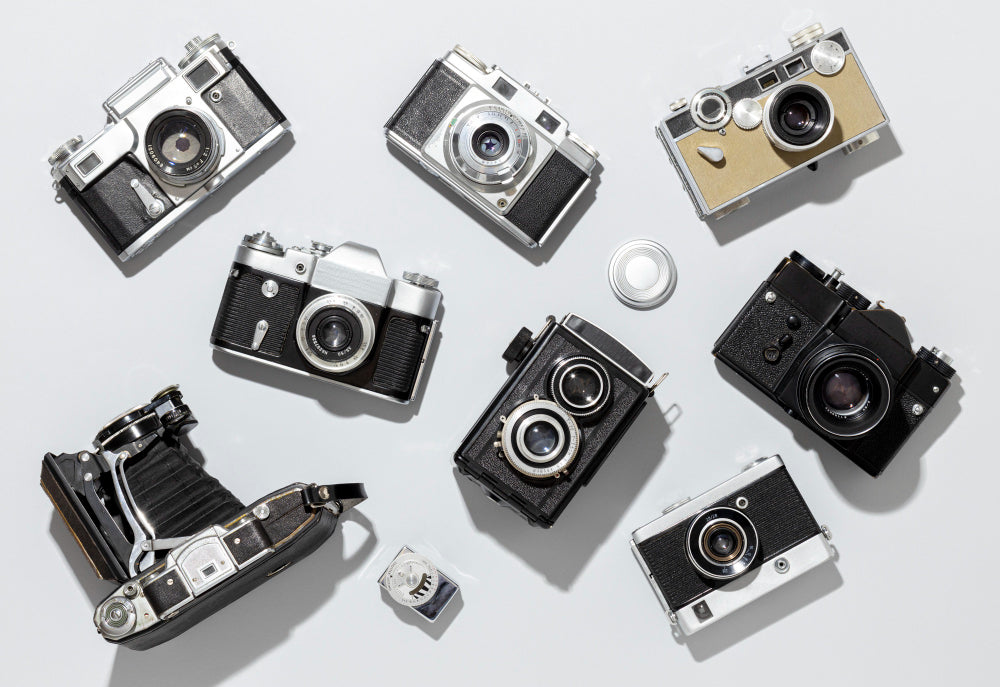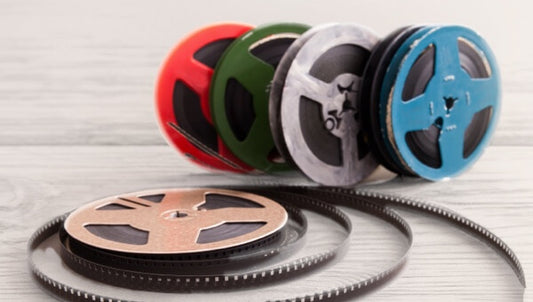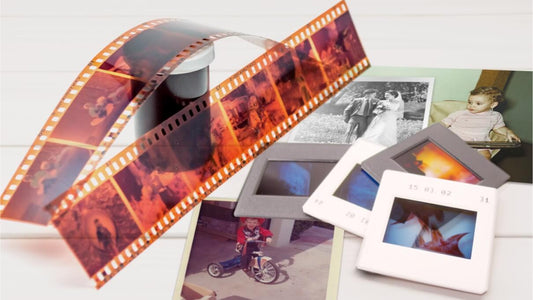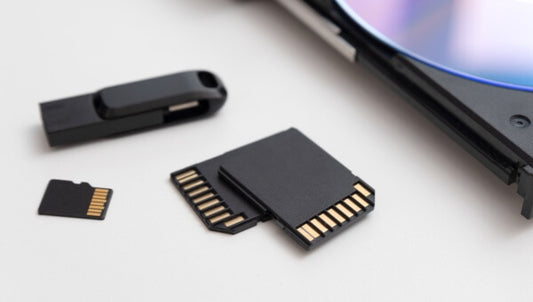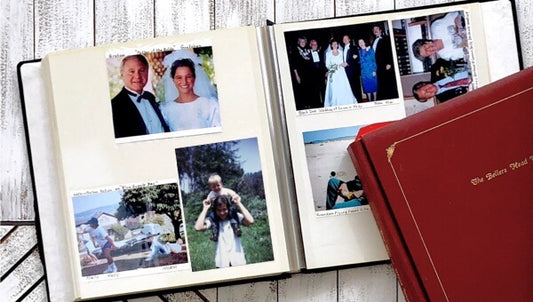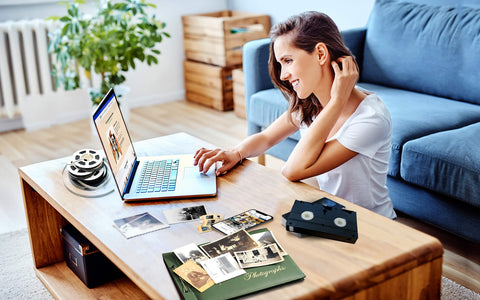Photography has been important not only for capturing your most precious family memories throughout the years, but for capturing historical records. In fact, the history of cameras can be traced back all the way to the 1600s and earlier. Capture archival experts have put together a complete evolution of the camera so you can learn how the technology progressed from pre-film cameras to the digital camera or smartphone you use to snap pictures of family events.
Keep reading to learn about major milestones in the evolution of cameras including camera obscura, daguerreotype, roll film, 35mm film, polaroid, digital cameras, and smartphones.
Quick List of the Evolution of the Camera Timeline
- The Camera Obscura: The First Camera - 400 BC to Early 1800s
- The Daguerreotype Camera: Early Photography – Early 1800s to Late 1800s
- Roll Film: Multiple Exposures – 1888 to 1934
- 35mm Film – 1934 – Early 2000s
- Polaroid – 1948 – 1990s
- Digital camera – 1969 to Current
- Smartphones – 1999 to Current
The Camera Obscura: The First Camera
The camera obscura is commonly thought of as the first camera and predecessor to film cameras. Camera obscura is Latin for “dark room” and is a natural phenomenon that projects an image through a small hole, or lens. Since this effect can be observed in natural circumstances, it has been traced back as far as circa 400 BC.

Image Source: https://mymodernmet.com/camera-obscura/
If you are wondering, “when was the first camera invented,” many people point to Ibn al-Haytham who invented the first pinhole camera box around 900 to 1000 AD. However, the first instance of people using a man-made object to produce a portable camera obscura effect has been traced back to around 1550.
During this time, the camera obscura was used as a drawing aid and optics were studied by famous thinkers including Leonardo da Vinci and Rene Descartes. In fact, the term photography was coined to mean “drawing with light!”
Then in 1685, Johann Zahn invented the first ever portable camera made for photography. However, it took over 100 years before a pinhole camera obscura effect produced the first permanent photograph.
In 1826, Joseph Nicephore Niepce used a sliding wooden box camera to manipulate the camera obscura phenomenon to expose pewter coated with bitumen for 8 hours. Then, in 1834, Henry Fox Talbot discovered how to fix images to paper using a combination of optics and chemistry. This made it possible to make multiple print negatives for the first time.
Camera Obscura’s use of light to expose contrasting images, control of light using a pinpoint lens, and the study of optics, in general, would all influence later photographic technologies that are more familiar including daguerreotypes and celluloid film.
The Daguerreotype Camera: Early Photography
After the first permanent photos in the early 1800s, photography developed even further in 1839 with the invention of the metal plate process called daguerreotype by Louis Daguerre. This format uses a copper plate coated with silver chloride that must be sensitized in iodine and developed using hot mercury. While that sounds complicated by today’s standards, it revolutionized photography of the era with a more efficient approach.

Image Source: http://www.photographyhistoryfacts.com/photography-development-history/daguerreotype/
The first photographic camera that was ever developed for commercial manufacturing was a mirrorless daguerreotype camera called the Giroux that had a rear box with a removable glass screen that could be used to adjust the focus. When the copper plate was inserted, the photographer opened the cover to expose it to light to produce an image.
This required several minutes to half an hour. However, later daguerreotype cameras as well as competing calotype cameras used new lens designs, improved the chemical process, and made other advancements to reduce the exposure time to only a few seconds.
One of the most important inventions of the 19th century era of cameras was the use of a concave mirror instead of a lens inside a daguerreotype camera. In 1839, Alexander Wolcott invented the mirror lens as the first US patent in photography. This meant faster exposure of only around 5 minutes!
This period of daguerreotype cameras was the beginning of many of the foundations of modern film photography including the use of chemicals for developing mirrors, modern lens types, and more. This paved the way for the first motion movie cameras and multi-exposure roll film cameras.
Roll Film: Multiple Exposures
In 1888 in Rochester, New York, George Eastman created the first camera that used a single roll of celluloid emulsion film, called The Kodak. This original Kodak camera would capture negatives in fractions of a second, significantly faster than older inventions in the history of the camera. The film would be sent to Eastman Kodak for development and was marketed as a point-and-shoot option.

Image Source: https://photojottings.com/kodak-brownie-flash-b-review-coffee-and-cream-anyone/
The original Kodak camera was so popular that the company became one of the largest American companies, which helped them continue to innovate new camera options including the historical Kodak Brownie in 1900.
The Brownie model was inexpensive and was the first time in the history of photography that an option was available to most middle-class families. That meant more people than ever before could capture weddings, parties, and family reunions.
Some of the innovations during this period would propel the evolution of the camera forward including multiple exposures on the same roll of film, a handheld point-and-shoot camera design, and the easy done-for-you photographic process.
35mm Film: Portability and Versatility
The next milestone for photographic film came in 1934 when Kodak introduced 135 film. This film was 35mm wide and made it possible to use the same size and type of film in cameras of any brand.
Plus, the camera operator would only have to place the film canister into the camera, wind it, and then it would automatically adjust as each photo was taken. Then, when the roll was finished, the photographer could open it without risking overexposure to the light-sensitive film.

Image Source: https://cameraville.co/blog/leicas-early-years-little-negatives-big-picture
While 35mm film was first invented by Kodak, the Leitz Leica camera brand led by Oskar Barnack would introduce many features that come standard on cameras today. The Leica One was created in 1930 and offered the ability to change out the lens. Later Leica models would introduce the modern viewfinder, range finder, and 1/1000th of a second shutter speed.
In the 1950s came the first Fujifilm twin-lens reflex camera (TLR) as well as the first single-lens reflex (SLR) camera with instant return mirrors including the Nikon F 35mm SLR complete with an entire array of lenses, motor drives, straps, and other accessories. Not long after, the inventor of the SLR camera Thomas Sutton would create the first color photograph in 1961.
The portable designs and ease-of-use for these camera inventions made photojournalism much more widespread. These inventions led to the development of the photo-heavy Life magazine in 1936 and would remain the standard for almost 80 years.
If you still have vintage 35mm negatives or slides tucked away, preserve those timeless memories by digitizing them. Our 35mm negatives to digital service transforms your cherished negatives into high-resolution digital files.
Similarly, if you have classic slides, our 35mm slides to digital solution ensures that every detail is captured in crisp digital quality for future generations.
Polaroid Camera: Instant Gratification
By this time, we’ve come a long way from 30-minute daguerreotype exposure times, but it only got faster with the invention of instant cameras. In 1948, Edwin Land invented the instant camera and founded the Polaroid Corporation which controlled the instant photography market.
Polaroid cameras work by taping the film negative to the film positive using silver halide emulsion. The user would peel the two pieces and discard the negative. Later versions of Polaroids would complete this process on their own. These instant Polaroid cameras were popular throughout the 1970s, 1980s, and into the 1990s.

Image Source: https://danfinnen.com/2021/09/24/polaroid-go-instant-film-camera-review/
For many, the iconic white‑framed Polaroid photo and the thrill of seeing your image develop in seconds are pure nostalgia. If you still have stacks of Polaroid prints, our photo digitization service makes it easy to convert them into digital keepsakes.
Instant cameras made sharing physical photos effortless at family gatherings - and our photo album scanning service ensures those instant memories are preserved in high‑quality digital format for years to come.
Digital Camera: The Digital Revolution
Early digital photography used a charged-couple device (CCD) that was developed in 1969. By 1975, the first digital camera working prototype was created by a Kodak engineer named Steven Sasson. However, this original digital camera was inconvenient with a resolution of .01 megapixels and a 23-second exposure time.
The first commercially available digital camera was created by Logitech and released as the Dycam Model 1 in 1990. It used similar CCD technology but recorded the data onto internal memory which made it possible to connect to your personal computer for viewing, downloading, and printing. In addition, digital manipulation software was also released in the early 1990s, which means you could process, manipulate, edit, and enhance digital photos at home.
Japanese manufacturers like Nikon and Canon soon revolutionized the market with Digital Single‑Lens Reflex (DSLR) cameras, joined by innovators such as Fuji and Sony. These cameras offered higher resolution, interchangeable lenses, and advanced control, and they remain industry leaders today. If you have a collection of digital photos stored on memory cards, our SD card transfer service makes it simple to back them up and preserve them for years to come.
Mirrorless & Modern DSLR Evolution
By the mid‑2000s, camera makers began shrinking bulky DSLRs into sleeker, lighter mirrorless models, ushering in a new era of professional‑quality photography without the heft. In 2008, Sony’s NEX‑3 became the first mass‑market mirrorless interchangeable‑lens camera, followed by Canon’s EOS M (2012) and Nikon’s Z series (2018). These systems combined DSLR‑level image sensors with electronic viewfinders, faster autofocus, and advanced video capabilities, all in bodies small enough to slip into a coat pocket. Today’s mirrorless cameras push boundaries with 8K video, AI subject tracking, and ultra‑high ISO performance, making them the go‑to choice for enthusiasts and pros alike.
Smartphone Cameras: The Camera in Your Pocket
There’s one final type of camera left and it’s the one most people use the most often these days: the camera phone. The first cell phone to offer a camera was the Kyocera VP-210 which was developed in 1999. The 2-inch screen allowed you to view photos instantly, but it wasn’t until the invention of the smartphone that mobile photography truly took off.

When the first Apple iPhone was released, you could send and receive digital photos easily between devices. These early iPhone models used complementary metal-oxide-semiconductors (CMOS) chips to replace the earlier CCD technology.
Modern devices now pack multiple lenses, computational photography algorithms, and AI‑powered editing into a device that fits in your pocket. In 2024, over 1.4 trillion photos were captured on smartphones worldwide, dwarfing all other camera formats combined, and more than 90 percent of images are shared instantly via social media apps. This shift underscores why nearly everyone today considers their phone to be their primary camera.
Lots of people have no use for standard digital cameras anymore because the quality of modern smartphones is so sophisticated. However, a digital camera does offer nostalgia as well as an easier ability to shoot action shots, low-light settings, and more.
While we can only guess the future of the evolution of the camera, automated cameras with artificial intelligence, automatic photo editing, facial recognition, and more will continue to take the history of the camera into new territories.

The Next Chapter in Your Photo Evolution
The camera obscura was the beginning of the evolution of the camera, but since then there have been significant milestones including the daguerreotype that allows for permanent, replicable photography and 35mm film and portable cameras that made home cameras more accessible and easier to use. In the modern age, digital cameras and smartphone cameras have taken over as the most popular and widely used types of cameras available.
Each of these milestones made it easier for families to capture important events like birthdays, weddings, graduations, births, and other memorable events. Still, lots of families still have these precious memories captured on film formats that can degrade over time. Capture's photo scanning service in Boston can update them to digital format to ensure your historical photo moments are preserved for future generations to share and enjoy. Let Capture transform your printed photos into digital keepsakes - get started today.

